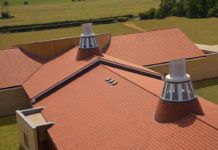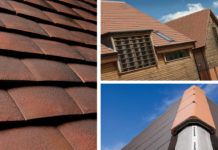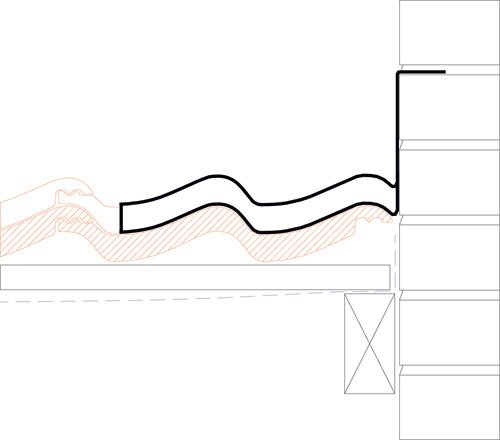
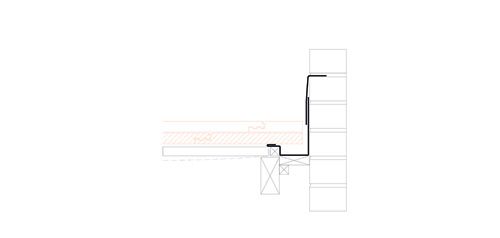
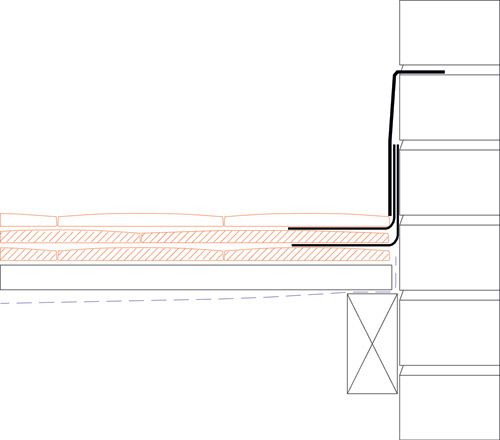
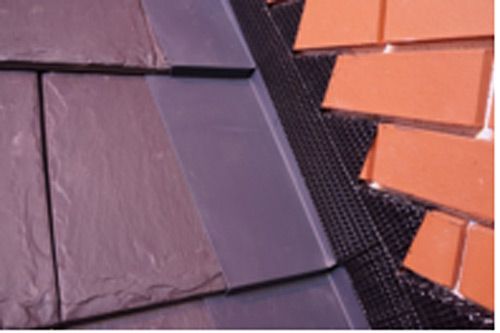
Of all the common standard details found on a tiled pitched roof, side abutments cause considerable confusion. There are several methods of weathering the junction between the tiling and a vertical wall, depending upon the type of tile. Therefore, in this article, I will show the common types of detail and describe the appropriate circumstances for each one.
Cover flashings
A cover flashing is installed over the tiles and extends up the wall by at least 75mm. The flashing can either turn 25mm into a cut or brickwork joints in the wall, or be covered by an additional separate step flashing that overlaps the upstand of the cover flashing by at least 65mm and turns into the wall by 25mm.
The cover flashing must extend over the tiles by at least 150mm. It must also extend over a complete tile roll or upstand; therefore, if necessary, the flashing may need to be wider to achieve this.
Cover flashings are generally only suitable for use on their own; i.e without soakers or side gutters, when used with profiled tiles. The roll or upstand in the tile profile prevents water from running sideways between the tile and flashing and leaking into the building. This means that cover flashings are not suitable for use with flat tiles or slates because there is no tile roll or upstand to prevent water passing between the tiles and flashing.
Secret gutters
A secret gutter is commonly used with flat single lapped tiles to weather the side abutment junction. It is installed under the tiles close to the wall to capture and drain away water that runs sideways off the tiles.
The gutter lining extends up the wall by at least 75mm above the top surface of the tiles and is covered by a step flashing.
The tiling is finished close to the wall; i.e with a gap of no more than 15mm wide, to prevent access for birds and rodents. If there is potentially a high water flow or a risk that debris such as leaves and pine needles etc. could enter and block the secret gutter, then a cover flashing can be installed in addition to the secret gutter.
Soakers
Traditional soakers are used with double lapped products such as plain tiles and slates. They are not suitable for use with single lapped tiles because they would not be supported under the tiles.
A soaker is placed between each tile headlap and is fully supported on the tile below. The length of a soaker is equal to the tile gauge + headlap + a short turn over the top of the tile; typically 100 + 65 + 25 = 190mm. Each soaker extends 100mm over the tile and 75mm up the wall. The soaker upstands are covered using a step flashing as described earlier.
Variations to common side abutment details
The traditional material for step and cover flashings, secret gutter and soakers is lead, usually Code 4 or Code 5 for exposed flashings and Code 3 for soakers. However, there are several lead replacement systems on the market suitable for these purposes. Similarly, pre-formed secret gutters (sometimes referred to as continuous soakers) and individual soakers for use with single lapped flat tiles are available in materials such as glass reinforced plastic (GRP) – (see photo above).
An alternative to the simple cover flashing commonly used in Scotland is to have an open side gutter at the abutment. This can be used with both profiled and flat tiles. The advantage is that the flashing does not then have to extend over the tiling and so is less visibly obtrusive.
In summary
– Cover flashings used in isolation are only suitable for use with profiled tiles because it is the shape of the tiles that prevents water leaking between the tiles and flashing.
– A secret gutter, or continuous soaker, is the better option for use with single lapped flat tiles as it captures water that runs off the sides of the tiles at the abutment. A cover flashing can be used in addition to the secret gutter for added protection against excess water flow and build-up of debris.
– Traditional soakers are used with double lapped plain tiles and slates. They are not suitable for use with single lapped flat tiles.

